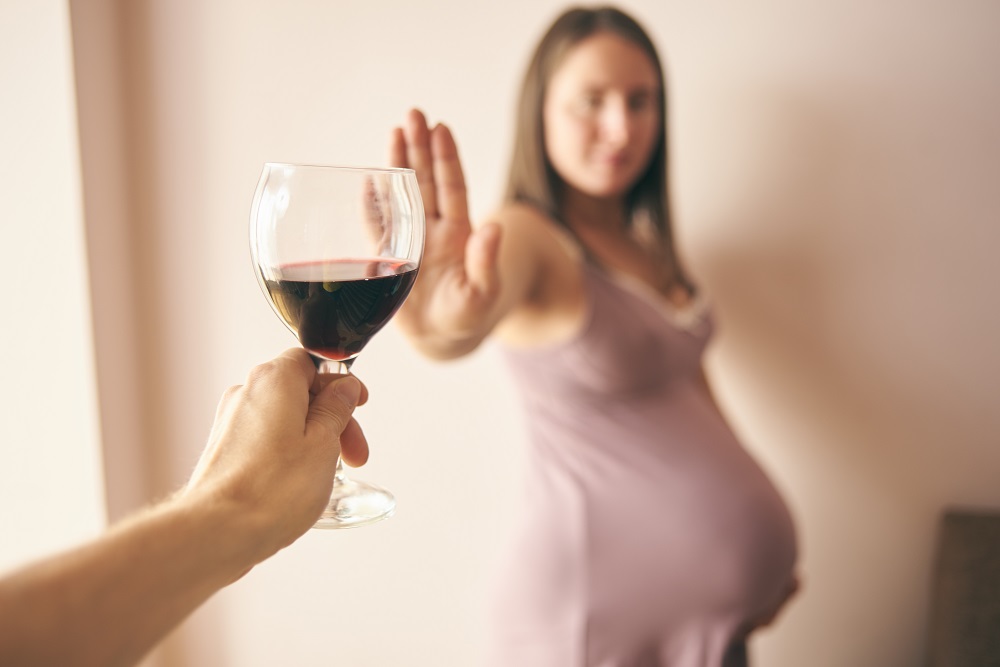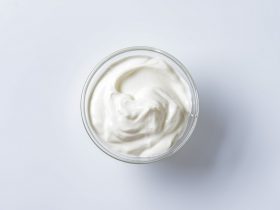Celebrating with a glass of champagne for any special occasion or during a holiday dinner brings a perfect picture for some. But if you are pregnant, you might think twice before enjoying yourself with this drink in hand.
Because there is no known safe amount of alcohol intake during pregnancy, the current recommendation for pregnant women is to avoid drinking all types of alcoholic beverage. This includes champagne, beer (and non-alcoholic beer), wine, and other spirits. The consequences of developing fetal alcohol syndrome are too great a risk for expectant mothers to take.
This article will present what we know so far regarding alcoholic beverage intake during pregnancy based on current evidence. Fetal alcohol syndrome, as well as its effects on infant and child health, will be discussed. Next, current recommendations regarding alcohol consumption during pregnancy will be given, followed lastly by some tips on how to avoid alcohol intake.
Dangers of Alcohol Exposure in Pregnancy

It is well known that alcohol exposure during pregnancy can lead to several birth defects. Alcohol is a known teratogen. When consumed during pregnancy, it can cross the placenta and reach the fetal circulation, causing damage to the developing organs of the fetus (Caputo et al., 2016).
Prenatal drinking of alcohol can cause brain damage to the unborn child, as well as cognitive and behavioral impairment (Hoyme et al., 2016). The brain is the most severely affected organ, but alcohol exposure causes abnormalities in the heart, kidney, liver, gastrointestinal tract, and the endocrine systems as well (Caputo et al., 2016).
The fetal liver is one of the last organs to mature and develop. Hence, unborn babies are not able to process alcohol from their system and it can seriously affect their development. The more the amount of alcohol consumed, the greater the risk for the baby.
Several studies have shown an association between alcohol consumption during pregnancy and miscarriage (Avalos et al., 2014). Drinking alcohol during the first trimester of pregnancy increases the risk for spontaneous abortion, premature birth and having a baby with low birth weight. Drinking alcohol during the latter stages of pregnancy increases the risk of having a child with learning difficulties and behavioral problems after they are born.
In 2014, Avalos et al. reported an increased risk of miscarriage among pregnant women who drank at least 4 drinks per week and those who drank spirits. However, it is still unclear what exactly is the amount, pattern and critical period of alcohol exposure needed for fetal harm to occur (Lim et al., 2019). In addition, evidence of the adverse effects of drinking low amounts of alcohol during pregnancy is limited.
Nevertheless, even binge drinking during pregnancy has been found to have a significant detrimental association to child cognition (Flak et al., 2014). In 2017, Mamluk et al., likewise, concluded in a meta-analysis that even light prenatal alcohol exposure of less than 32 grams per week was associated with preterm birth and small for gestational age babies.
The Center for Disease Control and Prevention (CDC) has defined alcohol use as having at least one drink over the past 30 days, and binge drinking as having at least five drinks on one occasion at least once in the past 30 days (Guelinckx et al., 2019). Therefore, there is no known safe amount of alcohol consumption during pregnancy (Flak et al., 2014), and preventive measures are of utmost importance (Caputo et al., 2016).
Learn More: Can You Drink Wine While Breastfeeding?
Fetal Alcohol Syndrome
Babies born to mothers who drink heavily can develop a health condition called Fetal alcohol syndrome (FAS). Symptoms of FAS include distinct facial features, poor growth, and learning and behavioral problems. The more a pregnant woman drinks alcohol, the greater the risk of developing FAS.
Fetal alcohol syndrome was first identified in the 1970’s in eight children born to alcoholic mothers. The children were found to demonstrate a similar pattern of craniofacial, limb, and cardiovascular defects that were prenatal in onset and associated with growth deficiency and developmental delay, for which ethanol toxicity was presumed to be the most likely cause (Jones et al., 1973).
Fetal alcohol spectrum disorder (FASD) is the term being used at present to refer to a range of disabilities that are caused by prenatal exposure to alcohol (Hoyme et al., 2016). FASD constitutes a wide range of adverse health outcomes, including damage to the brain, congenital anomalies, and deficits in cognitive, behavioral, emotional, and adaptive functioning (Lim et al., 2019).
The cognitive and behavioral effects associated with FASD include domains in general intelligence, executive functioning, language development, learning and memory, adaptive functioning, academic performance, and psychopathology (Mattson et al., 2019).
FAS is at the end of the spectrum of FASD and is characterized as the most severe form. The diagnosis of FAS requires presence of the following characteristic features (Mattson et al., 2019):
- Facial anomalies – short palpebral fissures, thin vermilion border, and smooth philtrum
- Growth deficiency – height and/or weight less than or equal to the 10th percentile for chronological age
- Abnormal brain growth – head circumference less than or equal to the 10th percentile, brain structure anomalies, or recurrent nonfebrile seizures
- Neurobehavioral impairment – cognitive or behavioral
Worldwide, FASD represents a prevalent developmental disability related to alcohol exposure that is highly preventable. Lange et al. in 2017 estimated the prevalence of FASD worldwide to be 7 per 1,000 population. Europe (19 per 1,000 population) and South Africa (111 per 1,000 population) were the WHO region and country, respectively, shown to have the highest prevalence of FASD.
What is Champagne?

Champagne is a form of classic sparkling wine named after the region of Champagne in northeastern France, where it is originally and exclusively produced. Outside France, the term champagne is also used to refer to white wines or rose wines, which are characterized by their effervescence.
Champagne is made from only three kinds of grapes: pinot and meunier, which are both black, and chardonnay, which is white. Pink champagne is made by the addition of a little amount of red wine, or by leaving the crushed grapes in contact with the skins for some time.
Champagne has an alcohol concentration of 10 to 13 percent by volume. This is relatively high compared to a standard beer that has an alcohol concentration between 4 to 6 percent by volume (Guelinckx et al., 2011).
Recommendations on Alcohol Consumption During Pregnancy
Pregnant women should be careful regarding information on alcohol coming from the alcohol industry-funded organizations, as they were found to be significantly inaccurate. They use indirect language and emphasize uncertainties by misrepresenting the evidence about the dangers of alcohol consumption during pregnancy to push pregnant women to continue drinking alcoholic beverages (Lim et al., 2019).
Scientific research findings on humans are unclear as to the pattern, amount and critical period of prenatal alcohol exposure to cause harm to the developing fetus. But animal models have shown that alcohol causes harm to all stages of embryonic development (Lange et al., 2017).
There is no amount, no matter how little, of exposure to alcohol that is proven to be safe in pregnancy. The safest choice for pregnant women is to abstain from drinking any alcohol throughout pregnancy (Gouilhers et al., 2019). Hence, official guidelines emphasize the need for precautionary abstinence (Lim et al., 2019).
U.K. guidelines advise abstinence from alcohol during pregnancy. Other health organizations take a similar preventive approach (Lim et al., 2019). Official health care guidelines in the majority of the Western countries also apply the precautionary principle of abstinence from alcohol consumption during pregnancy (Gouilhers et al., 2019).
Tips on How to Avoid Alcohol During Pregnancy
Some pregnant women find the taste of alcohol off, especially during the early stages of pregnancy. Others give up drinking alcohol altogether once they realize that they are pregnant or when they are planning to become pregnant. Women who do not know yet that they were pregnant and have already drunk alcohol should avoid any further drinking.
If a pregnant woman is having difficulty avoiding alcohol, talking to a health care specialist can help. There are also confidential support and local counseling services available, such as Drinkline, We are with you, and Alcoholics anonymous.
Final Thoughts
Prenatal exposure of a baby to alcohol can lead to a wide range of anomalies, including growth retardation, premature delivery, craniofacial dysmorphism, neurological and behavioral disorders, and disorders of cognitive function. All these can persist through adulthood and represent a significant pathology that is highly preventable.
For this reason, total abstinence from alcohol intake during pregnancy is recommended. If you are pregnant and are having trouble keeping away from alcoholic beverages, seek help. Talk to your health care provider or find support from counseling services.
References
- https://www.webmd.com/baby/features/drinking-alcohol-during-pregnancy
- https://www.nhs.uk/pregnancy/keeping-well/drinking-alcohol-while-pregnant/
- https://www.statista.com/statistics/269735/alcohol-content-of-a-glass-of-beer-wine-champagne-and-spirits/
- https://www.britannica.com/topic/champagne-alcoholic-beverage
- https://www.alcoholrehabguide.org/alcohol/types/
- Avalos, L. A., Roberts, S., Kaskutas, L. A., Block, G., & Li, D. (2014). Volume and type of alcohol during early pregnancy and the risk of miscarriage. Substance Use & Misuse 49(11), 1437-1445. doi: 10.3109/10826084.2014.912228
- Caputo, C., Wood, E., & Jabbour, L. (2016). Impact of fetal alcohol exposure on body systems: A systematic review. Birth Defects Research: Part C, Embryo Today 108(2), 174-180. doi: 10.1002/bdrc.21129
- Flak, A., Su, S., Bertrand, J., Denny, C., Kesmodel, U., & Cogswell, M. (2014). The association of mild, moderate, and binge prenatal alcohol exposure and child neuropsychological outcomes: A meta-analysis. Alcoholism, Clinical and Experimental Research 38(1), 214-226. doi: 10.1111/acer.12214
- Gouilhers, S., Meyer, Y., Inglin, S., Boulenaz, S. P., Schnegg, C., & Hammer, R. (2019). Pregnancy as a transition: First-time expectant couples’ experience with alcohol consumption. Drug and Alcohol Review 38(7), 758-765. doi: 10.1111/dar.12973
- Guelinckx, I., Devlieger, R., & Vansant, G. (2011). Alcohol during pregnancy and lactation: Recommendations versus real intake. Archives of Public Health 68(4), 134-142. doi: 10.1186/0778-7367-68-4-134
- Hoyme, H. E., Kalberg, W., Elliott, A., Blankenship, J., Buckley, D., Marais, A., …, & May, P. (2016). Updated clinical guidelines for diagnosing fetal alcohol spectrum disorders. Pediatrics 138(2), e20154256. doi: 10.1542/peds.2015-4256
- Jones, K. L., Smith, D. W., Ulleland, C. N., & Streissguth, P. (1973). Pattern of malformation in offspring of chronic alcoholic mothers. Lancet 1(7815), 1267-1271. doi: 10.1016/s0140-6736(73)91291-9
- Lange, S., Probst, C., Gmel, G., Rehm, J., Burd, L., & Popova, S. (2017). Global prevalence of fetal alcohol spectrum disorder among children and youth: A systematic review and meta-analysis. JAMA Pediatrics 171(10), 948-956. doi: 10.1001/jamapediatrics.2017.1919
- Lim, A., Van Schalkwyk, M., Hessari, N. M., & Petticrew, M. (2019). Pregnancy, fertility, breastfeeding, and alcohol consumption: An analysis of framing and completeness of information disseminated by alcohol industry-funded organizations. Journal of Studies on Alcohol and Drugs 80(5), 524-533. doi: 10.15288/jsad.2019.80.524
- Mamluk, L., Edwards, H., Savovic, J., Leach, V., Jones, T., Moore, T., …, & Zuccolo, L. (2017). Low alcohol consumption and pregnancy and childhood outcomes: Time to change guidelines indicating apparently ‘safe’ levels of alcohol during pregnancy: A systematic review and meta-analyses. BMJ Open 7(7), e015410. doi: 10.1136/bmjopen-2016-015410
- Mattson, S., Bernes, G., & Doyle, L. (2019). Fetal alcohol spectrum disorders: A review of the neurobehavioral deficits associated with prenatal alcohol exposure. Alcoholism: Clinical and Experimental Research 43(6), 1046-1062. doi: 10.1111/acer.14040




